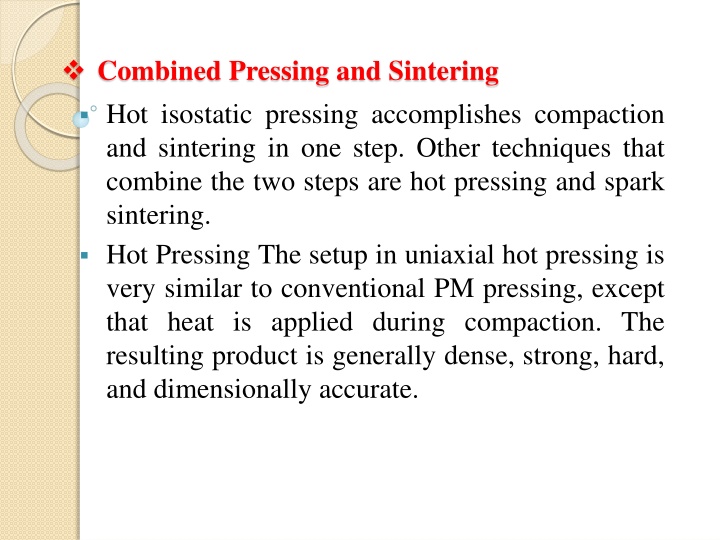
Advanced Techniques in Powder Metallurgy
Explore advanced techniques such as hot pressing, spark sintering, liquid phase sintering in powder metallurgy for achieving dense, strong, and precise parts with unique characteristics. Learn about the challenges and benefits of these methods.
Uploaded on | 1 Views
Download Presentation

Please find below an Image/Link to download the presentation.
The content on the website is provided AS IS for your information and personal use only. It may not be sold, licensed, or shared on other websites without obtaining consent from the author. If you encounter any issues during the download, it is possible that the publisher has removed the file from their server.
You are allowed to download the files provided on this website for personal or commercial use, subject to the condition that they are used lawfully. All files are the property of their respective owners.
The content on the website is provided AS IS for your information and personal use only. It may not be sold, licensed, or shared on other websites without obtaining consent from the author.
E N D
Presentation Transcript
Combined Pressing and Sintering Hot isostatic pressing accomplishes compaction and sintering in one step. Other techniques that combine the two steps are hot pressing and spark sintering. Hot Pressing The setup in uniaxial hot pressing is very similar to conventional PM pressing, except that heat is applied during compaction. The resulting product is generally dense, strong, hard, and dimensionally accurate.
Despite these advantages, the process presents certain technical problems that limit its adoption. Principal among these are: (1) selecting a suitable mold material that can withstand the high sintering temperatures; (2) longer production cycle required to accomplish sintering; and (3) heating and maintaining atmospheric control in the process. Hot pressing has found some application in the production of sintered carbide products using graphite molds.
Spark combines pressing and sintering but overcomes some of the problems in hot pressing is spark sintering. The process consists of two basic steps: (1) powder or a green compacted preform is placed in a die; and (2) upper and lower punches, which also serve as electrodes, compress the part and simultaneously apply a high-energy electrical current that burns off surface contaminants and sinters the powders, forming a dense, solid part in about 15 seconds. The process has been applied to a variety of metals. Sintering An alternative approach that
Liquid Phase Sintering Conventional sintering is solid-state sintering; the metal is sintered at a temperature below its melting point. In systems involving a mixture of two powder metals, in which there is a difference in melting temperature between the metals, an alternative type of sintering is used, called liquid phase sintering. 16.5
In this process, the two powders are initially mixed, and then heated to a temperature that is high enough to melt the lower melting- point metal but not the other. The melted metal thoroughly wets the solid particles, creating a dense structure with strong bonding between the metals upon solidification.
Depending on the metals involved, prolonged heating may result in alloying of the metals by gradually dissolving the solid particles into the liquid melt and/or diffusion of the liquid metal into the solid. In either case, the resulting product is fully densified (no pores) and strong. Examples of systems that involve liquid phase sintering include Fe Cu, W Cu, and Cu Co.





















